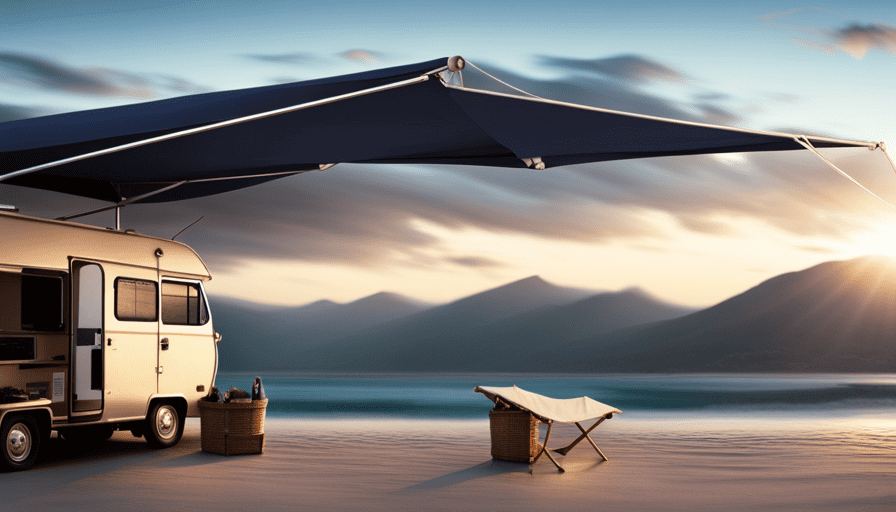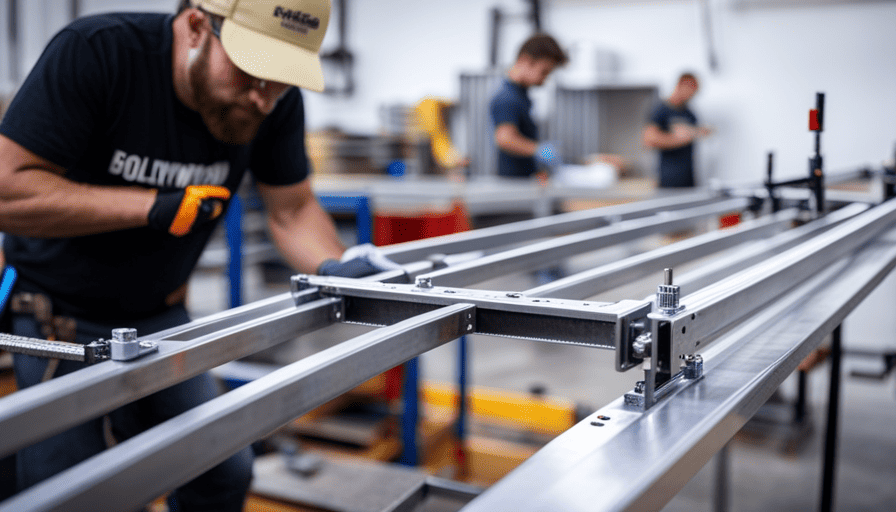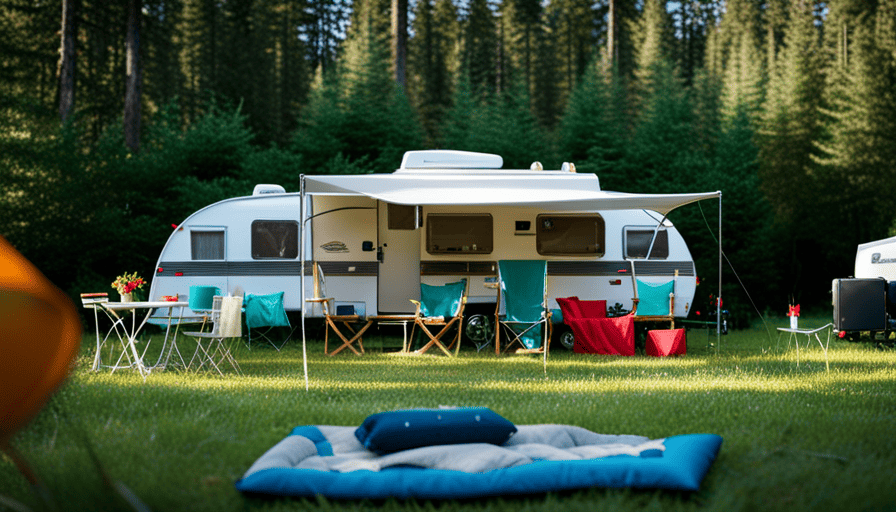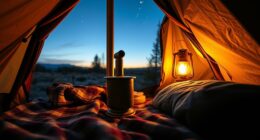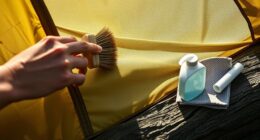What is the level of wind resistance for a camper awning?
It’s a question that every camper should ask themselves before embarking on their outdoor adventures. Understanding the limits of your camper awning is not only crucial for its longevity but also for your safety and comfort while camping.
In this article, I will delve into the construction of camper awnings, the factors that determine their wind resistance, and the recommended wind speed limits. I will also provide valuable tips on how to properly secure your awning and offer alternative options for camping in windy conditions.
Additionally, I will discuss common mistakes to avoid and highlight the importance of maintenance and care for your camper awning. By the end of this article, you will be equipped with the knowledge and tools necessary to enjoy safe and secure camping adventures, no matter the wind conditions.
Key Takeaways
- Understanding the wind resistance of camper awnings is crucial for their durability and functionality.
- The construction and materials used in the awning, as well as proper installation and securing methods, all contribute to its wind resistance.
- Manufacturers provide recommended wind speed limits and guidelines for awning usage to ensure safety.
- Properly securing the awning using straps or ropes and utilizing wind-resistant materials can significantly increase its ability to withstand wind.
Understanding the Construction of Camper Awnings
You’ll be amazed by the intricate design and sturdy materials used in camper awnings, giving you peace of mind when facing strong winds.
Camper awnings are constructed using a combination of durable materials that are designed to withstand various weather conditions. The fabrics used in camper awnings are typically made from high-quality materials such as polyester or acrylic. These materials are known for their strength and resistance to tearing, ensuring that the awning can handle the forces exerted by strong winds.
In addition to the materials used, the installation of the camper awning also plays a crucial role in its wind resistance. The awning must be properly secured to the camper, with sturdy brackets and supports ensuring stability. This prevents the awning from being easily uprooted or damaged by strong gusts of wind.
Factors that determine the wind resistance of a camper awning include the size and shape of the awning, as well as the angle at which it is installed. Awnings with a smaller surface area and a more compact shape tend to be more wind-resistant, as they create less drag. Additionally, installing the awning at a slight angle can help reduce wind resistance by allowing the wind to pass over it more smoothly.
With a solid understanding of the construction and installation of camper awnings, we can now delve into the factors that determine their wind resistance.
Factors that Determine Wind Resistance
When it comes to determining the wind resistance of a camper awning, there are several key factors to consider. Firstly, the material and design of the awning play a crucial role in how well it can withstand strong winds.
Secondly, the installation and anchoring methods used can greatly impact the awning’s ability to withstand wind forces.
Lastly, the weather conditions and wind speeds in a specific location are important considerations when determining the wind resistance of a camper awning.
By examining these factors in detail, we can gain a better understanding of how to maximize the wind resistance of camper awnings.
Material and Design of the Awning
Crafted with durable materials and a sturdy design, this camper awning is a fortress against the relentless winds of Mother Nature, standing strong like a mighty oak amidst a storm. The materials used in the construction of the awning play a crucial role in its wind resistance.
High-quality fabrics like vinyl-coated polyester or acrylic are commonly used due to their strength and ability to withstand strong winds. These materials are designed to be tear-resistant, UV resistant, and water repellent, ensuring the awning remains intact even in harsh weather conditions.
Additionally, the design of the awning also contributes to its wind resistance. A well-engineered awning will have a sloping shape to allow wind to pass over it smoothly, minimizing the chances of it catching the wind and getting damaged. Moreover, strategic reinforcements and sturdy frame construction further enhance the awning’s ability to withstand strong winds.
Moving on to the installation and anchoring methods, they also play a significant role in determining the wind resistance of the awning.
Installation and Anchoring Methods
To ensure your awning stays securely in place, it’s important to properly install and anchor it using reliable methods. There are various anchoring techniques that can be used, depending on the type of surface you are installing the awning on. Some recommended tools for anchoring include ground anchors, screw-in stakes, and tension straps. Ground anchors are especially useful for securing the awning on grass or soil, while screw-in stakes are ideal for hard surfaces like concrete or asphalt. Tension straps can be used in conjunction with other anchoring methods to provide additional stability. By using these anchoring techniques and tools, you can minimize the risk of your awning being damaged or blown away by strong winds. Moving on to the next section about weather conditions and wind speeds…
Weather Conditions and Wind Speeds
Imagine being able to enjoy your outdoor space without worrying about the unpredictable weather or strong gusts that could potentially ruin your relaxing time under the shade. When it comes to camper awnings, it’s crucial to consider the weather-related risks and the importance of proper anchoring.
Weather conditions, such as high winds, can pose a significant threat to your awning if it’s not properly secured. The awning fabric can become damaged or even torn, leaving you exposed to the elements. That’s why it’s essential to ensure that your awning is properly anchored to withstand strong winds. This can be achieved through various methods, such as using sturdy stakes or tie-downs.
By taking these precautions, you can enjoy your outdoor space without worrying about the weather.
Now, let’s discuss the recommended wind speed limits for camper awnings.
Recommended Wind Speed Limits for Camper Awnings
Withstand the power of the wind, and your camper awning becomes a shield against nature’s fury. When it comes to camper awnings, knowing the recommended wind speed limits is crucial to ensure their durability. Check the manufacturer’s guidelines for the specific wind speed limit for your camper awning. It’s also important to consider the size and weight of your camper and the type of terrain you’ll be camping on. Additionally, be mindful of the power needs of your equipment, especially when considering camper generator sizes.
Exposing your awning to excessive wind speeds can lead to damage or even complete destruction. To help you understand the importance of wind speed limits, here are three key factors to consider:
-
Manufacturer’s Recommendations: Each camper awning has its own recommended wind speed limits, which are typically provided by the manufacturer. These limits are determined based on extensive testing and are designed to protect your awning from potential damage.
-
Awning Design and Construction: The design and construction of your camper awning play a significant role in its ability to withstand strong winds. Awnings with sturdy frames, reinforced stitching, and robust materials are more likely to endure high wind speeds.
-
Weather Conditions: It’s essential to consider the current weather conditions before deploying your awning. Even if the wind speed is within the recommended limits, gusty or turbulent winds can still pose a risk. Always evaluate the overall weather forecast and use your judgment to determine if it’s safe to extend your awning.
Understanding the recommended wind speed limits for your camper awning and taking into account factors such as the manufacturer’s recommendations, awning design, and current weather conditions will help ensure its durability.
Now, let’s explore how to properly secure your camper awning and further protect it from the forces of nature.
How to Properly Secure Your Camper Awning
Securing your camper awning properly is like locking the fortress gates to shield against the unpredictable forces of nature. To ensure your awning stays in place during windy conditions, it is crucial to employ effective securing techniques and utilize wind resistant materials.
One way to secure your camper awning is by using sturdy straps or ropes to tie it down. These should be tightly fastened to the ground or nearby structures, such as trees or poles. Additionally, attaching weights or sandbags to the base of the awning can provide extra stability.
Another important aspect of securing your awning is choosing the right materials. Opt for awnings made from wind resistant materials, such as polyester or vinyl. These materials are designed to withstand strong winds and reduce the risk of damage.
To further illustrate the importance of proper securing techniques and wind resistant materials, refer to the table below:
| Securing Techniques | Wind Resistant Materials | Benefits |
|---|---|---|
| Use straps or ropes to tie down the awning | Choose polyester or vinyl material | Increases stability and resistance to wind |
| Attach weights or sandbags to the base of the awning | Opt for reinforced stitching and durable construction | Provides additional anchoring and prevents damage |
By employing these securing techniques and utilizing wind resistant materials, you can significantly reduce the risk of your camper awning getting damaged or blown away in strong winds. With your awning securely in place, you can now focus on enjoying your camping experience, even in windy conditions.
Transitioning to the next section about tips for camping in windy conditions, it’s important to be prepared for the challenges that may arise.
Tips for Camping in Windy Conditions
Now that we know how to properly secure our camper awning, let’s talk about camping in windy conditions. It’s important to be prepared for unpredictable weather when you’re out in nature, and wind is no exception. When the wind starts to pick up, it can be a challenge to keep your camping equipment in place and your tent stable. That’s why investing in wind-resistant tents is a smart choice.
Wind-resistant tents are specifically designed to withstand strong winds and keep you safe and comfortable during your camping trip. These tents are made with durable materials and feature sturdy poles that can withstand the force of the wind. They also have reinforced stitching and guy lines that provide added stability.
When camping in windy conditions, here are a few tips to keep in mind:
- Choose a sheltered campsite if possible, such as one surrounded by trees or natural formations.
- Set up your tent with the narrow end facing into the wind to reduce wind resistance.
- Use extra guy lines and stakes to secure your tent to the ground.
By following these tips and investing in wind-resistant tents, you can enjoy your camping trip even when the weather gets gusty. And speaking of weather, it’s important to keep an eye out for signs of damage or wear on your camper awning.
Signs of Damage or Wear on Your Camper Awning
When the elements have taken their toll, you’ll notice the signs of wear and tear on your camper awning, like a tired old warrior with battle scars. It’s important to keep an eye out for these signs, as they can indicate potential damage and the need for repairs.
One of the most common signs of wear and tear on a camper awning is frayed or torn fabric. This can occur from strong winds, sharp objects, or simply from years of use. If you notice any fraying or tearing, it’s crucial to address the issue promptly to prevent further damage. Thankfully, repairing a damaged camper awning is often a straightforward process.
Small tears can be patched using a repair kit specifically designed for awning fabric, while larger tears may require professional assistance. Additionally, regularly inspecting your awning for signs of wear, such as fading or discoloration, can help you catch any potential issues early on. By taking the time to properly maintain and repair your camper awning, you can ensure its longevity and enjoyment for years to come.
Moving on to the next section about maintenance and care for camper awnings…
Maintenance and Care for Camper Awnings
To ensure the longevity and optimal performance of your camper awning, it’s crucial that you properly maintain and care for it. Neglecting regular maintenance can lead to a decrease in functionality and an increase in the likelihood of damage.
Here are four important steps you can take to keep your camper awning in top shape:
-
Regular cleaning: Regularly cleaning your camper awning is essential to prevent the build-up of dirt, debris, and pollutants. Use a mild soap and water solution to gently scrub the fabric, ensuring you remove any stains or residue that may have accumulated over time.
-
Proper storage: When not in use, it’s important to store your camper awning correctly. Make sure it’s completely dry before folding and storing it to prevent the growth of mold and mildew.
-
Inspect for damage: Regularly inspect your camper awning for any signs of damage, such as tears, loose stitching, or bent components. Addressing these issues promptly can prevent further damage and costly repairs.
-
Protect from harsh weather: During severe weather conditions, it’s advisable to retract your camper awning to protect it from high winds, heavy rain, or snowfall. This will help prevent unnecessary stress on the awning fabric and mechanisms.
Taking these steps to maintain and care for your camper awning will ensure its longevity and optimal performance.
In the next section, we’ll discuss common mistakes to avoid with camper awnings in windy conditions, which will further help you protect your investment.
Common Mistakes to Avoid with Camper Awnings in Windy Conditions
Avoiding these common mistakes will help you protect your investment and ensure your camper awning stays secure in windy conditions.
Windy conditions can pose a significant threat to your camper awning if not properly handled. One of the most common mistakes people make is failing to properly secure the awning. It’s crucial to always use sturdy stakes and tie-downs to anchor your awning to the ground. This will prevent it from getting blown away by strong gusts of wind.
Additionally, make sure to regularly inspect the condition of your awning. Look for any signs of wear and tear, such as frayed fabric or damaged poles. Addressing these issues promptly will help prevent accidents and keep your awning in good shape.
Lastly, choosing the right awning for your camper is essential. Consider the size and weight of the awning, as well as its wind resistance capabilities. Investing in a high-quality, wind-resistant awning will provide you with added peace of mind during windy camping trips.
As you learn how to avoid these common mistakes and choose the right awning, you’ll be well-prepared to handle windy conditions during your camping adventures.
Now, let’s explore alternative options for windy camping environments.
Alternative Options for Windy Camping Environments
Now that we’ve discussed the common mistakes to avoid with camper awnings in windy conditions, let’s explore some alternative options for camping in windy environments.
One option is to invest in a wind-resistant tent. These tents are designed with stronger materials and reinforced construction to withstand high winds. They often have aerodynamic shapes and additional guy lines for added stability. Look for tents that have been tested in windy conditions and have a high wind resistance rating.
Another option is to use windbreaks for camping. These can be natural features such as trees or rocks that provide a barrier against the wind. Alternatively, you can set up a portable windbreak using tarps or screens. Positioning your tent behind a windbreak can significantly reduce the impact of strong gusts and create a more sheltered camping area.
By utilizing wind-resistant tent options and windbreaks, you can enjoy a more secure and comfortable camping experience in windy conditions. These alternatives will help protect your awning and ensure that you can relax and enjoy the outdoors without worrying about the wind.
By implementing these strategies and being mindful of the common mistakes to avoid, you can have safe and secure camping adventures.
Conclusion: Enjoying Safe and Secure Camping Adventures
Imagine embarking on safe and secure camping adventures, where you can fully immerse yourself in the beauty of nature and create lasting memories. To ensure a worry-free experience, it’s essential to prioritize camping safety and equip yourself with windproof gear. By investing in reliable equipment and following some key guidelines, you can enjoy the great outdoors without compromising your security.
When it comes to camping in windy environments, having the right gear is crucial. Here are two sub-lists that’ll help you visualize the importance of windproof gear:
-
Clothing:
- Windproof jackets: These jackets are designed to resist strong winds, keeping you warm and comfortable.
- Windproof pants: Similar to jackets, windproof pants provide an extra layer of protection against the elements.
-
Shelter:
- Windproof tents: Look for tents specifically designed to withstand high winds, with sturdy poles and reinforced materials.
- Windproof awnings: These awnings are specially built to withstand strong gusts of wind, providing you with a safe and secure shelter.
By investing in windproof gear, you can ensure that your camping adventures remain enjoyable and safe, no matter the weather conditions. Remember to always check the weather forecast before setting up camp and to secure your gear properly. With the right equipment and a bit of preparation, you can fully embrace the beauty of nature while staying protected from the elements.
Frequently Asked Questions
Can camper awnings withstand hurricane-level winds?
Camper awnings aren’t designed to withstand hurricane-level winds. They’re typically constructed to handle moderate winds, usually up to around 20-25 mph. To ensure wind resistance, awnings should be properly secured to the camper using sturdy brackets and straps. It’s crucial to regularly check the awning’s condition and make any necessary repairs or replacements to maintain its structural integrity. Additionally, retracting the awning during severe weather conditions is a vital safety measure.
What are the potential consequences of exceeding the recommended wind speed limits for camper awnings?
Exceeding the recommended wind speed limits for camper awnings can have a range of potential dangers. The awning may become damaged or completely detached, posing a risk to both the camper and surrounding property. It can also lead to structural damage to the camper itself.
To avoid these consequences, it’s essential to regularly inspect and maintain the awning, ensuring it’s properly secured and in good condition. Additionally, always check weather forecasts and retract the awning during inclement or high-wind conditions.
Are there any additional precautions to take when camping in areas known for high winds?
When preparing for high winds while camping, it’s important to take additional precautions to ensure the safety of your awning. Securing awnings safely should be a top priority. This can be done by using sturdy and reliable anchor points, such as ground stakes or tie-down straps.
Additionally, reinforcing the awning with extra support poles or braces can help withstand strong gusts. Regularly checking and maintaining the awning’s condition is also crucial for optimal performance in high wind conditions.
How often should camper awnings be inspected for damage or wear?
Camper awnings should be inspected for damage or wear on a regular basis to ensure their longevity and functionality. The recommended maintenance schedule for camper awnings typically includes an inspection every three months, or before and after each camping trip.
During these inspections, one should closely examine the fabric, frame, and any moving parts for signs of tears, fraying, rust, or other issues. Regular inspections help identify and address any potential problems before they worsen and require costly repairs.
Can camper awnings be repaired if they become damaged in windy conditions?
Camper awnings can often be repaired on your own, but sometimes professional help may be necessary. It depends on the extent of the damage and your DIY skills.
Common causes of damage to camper awnings in windy conditions include strong gusts, improper installation, and poor maintenance. It’s crucial to inspect your awning regularly for tears, bent parts, or loose fasteners.
Taking prompt action and making necessary repairs can help prevent further damage and ensure the longevity of your awning.
Can a Camper Awning Withstand the Same Amount of Wind as the Camper Itself?
When it comes to wind resistance for camping trailers, it’s important to consider the reliability of camper awnings. While campers are built to withstand varying wind speeds, awnings might not possess the same level of durability. Proper anchoring and regularly checking weather conditions are essential to ensure both the camper and its awning stay secure against strong winds.
Conclusion
In conclusion, it’s fascinating to see how much wind a camper awning can withstand. With careful construction and design, these awnings can handle some seriously strong gusts. It’s almost ironic that something so seemingly fragile can hold up against the forces of nature. If you’re planning to use a camper awning in windy conditions, it’s also important to consider the size and strength of your camper generator. Using a camper generator size calculator can help you determine the appropriate power output for your specific needs, which can ensure that your awning remains stable and secure. By taking into account both the construction of the awning and the capabilities of your generator, you can enjoy the great outdoors without worrying about the effects of strong winds.
By following the recommended wind speed limits, properly securing your awning, and taking precautions in windy conditions, you can enjoy a safe and secure camping experience. Remember, while camper awnings are impressive, it’s always wise to have alternative options on hand for those extra blustery days. Happy camping!

